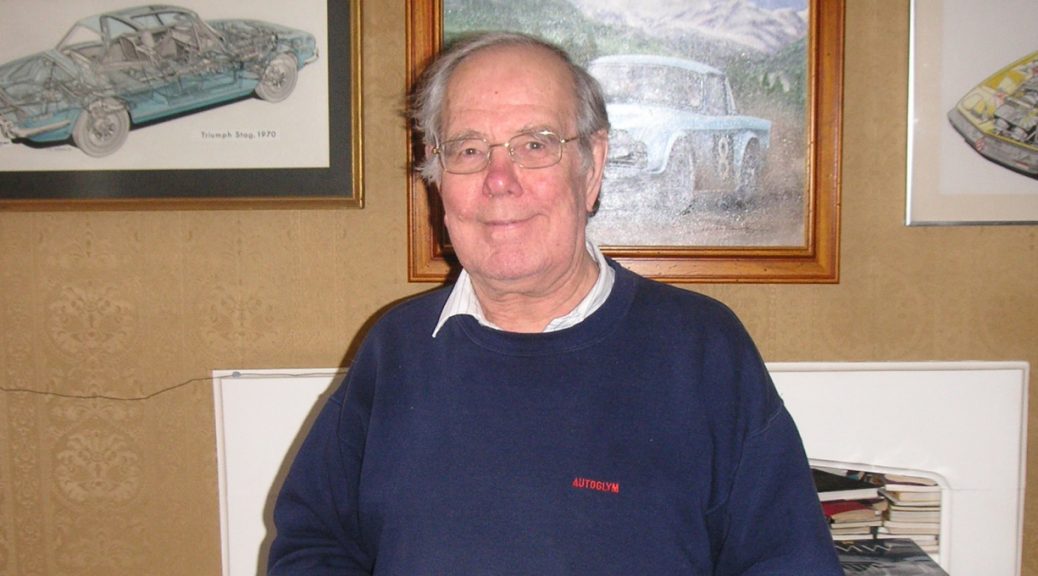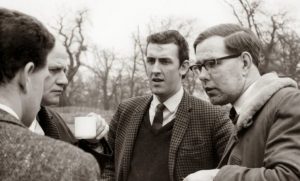
Graham Robson: “He Was Always, Triumphantly, in Touch”
It was typical of my dear friend of 47 years that he wrote his own advance obituary, for Classic and Sports Car. Graham Robson always planned ahead. I quote from it below, hoping to approximate the magnitude of our loss.
Alec Arthur Graham Robson 1936-2021

Graham was born in Skipton, Yorkshire, the only child of Clifford and Kathleen Robson. He was educated locally before going to Lincoln College, Oxford, where he read Engineering. His first job was as a graduate trainee at Jaguar Cars in 1957. His subsequent career became a perfect training path for someone destined to become a leading author.
In 1961 Robson became a development engineer, then competition secretary at Standard-Triumph, then a writer for The Autocar. By 1969 he was at the Rootes Group as chief engineer, product proving. He became a full-time independent motoring writer, researcher and author in 1972.
That word “independent” cannot be stressed too highly, because whatever his links with the manufacturer of a car he was writing about, his research was always thorough and he never pulled his punches. He wrote nearly 170 books and countless articles—one of most prolific motoring writers ever. Many Robson books were about motorsport, for he had been a rally co-driver in the mid-Fifties. His passion for writing was triggered by his 1950s rally reports for Motoring News.
Quantity did not affect quality. Robson books were all meticulously researched and well written. On many subjects his books are now the “standard works.” Because of his wide knowledge, Robson was also a frequent master of ceremonies or commentator for national club events. He was president, vice-president or an honorary member of several Triumph clubs.
Graham married Pamela in 1962 and they had two sons. Hamish is now a senior design engineer with Toyota Motorsport in Germany. Jonathan is a landscape gardener in Dorset. In 1981 Robson moved from the Lake District to a picture-postcard village in Dorset, thereafter traveling widely on business and pleasure. Sadly, Pamela died in 2014 after a long illness.
Triumphant passage
I wrote Graham in 1974, after I wrote a brief history of Triumph for my employer, Automobile Quarterly magazine. He had recently published The Story of Triumph Sports Cars (1973). And so I wrote with trepidation, the acolyte at the foot of Olympus. He couldn’t have been kinder over my amateurish efforts. After I became a freelance, we met personally in London. There to my astonishment, he offered to co-author with me a complete history of our mutual passion, Triumph Cars, and to find us a publisher.
 Appearing in 1977, the book has had a long run in three editions—the current, and by far the most elaborate, in 2018. While I had equal billing, Graham sold the job to Veloce Publishing, and did literally all the work. I had, originally, written Triumph’s history through 1940, and a few postwar sections. That part of the story was told. But Graham had to update everything that had happened since the previous edition in 2004.
Appearing in 1977, the book has had a long run in three editions—the current, and by far the most elaborate, in 2018. While I had equal billing, Graham sold the job to Veloce Publishing, and did literally all the work. I had, originally, written Triumph’s history through 1940, and a few postwar sections. That part of the story was told. But Graham had to update everything that had happened since the previous edition in 2004.
He tackled the job with his usual celerity, rounding up dozens of exciting new photographs. The fabled 1930s Dolomite Straight Eight was also Graham’s to update: he had test-driven the newly restored car it in the 2000s. He never complained and treated me as his full partner. As a result of his efforts, Triumph Cars is one of my two proudest automotive histories.
Sunbeam sublimities
Graham helped in innumerable other ways. Together we co-authored the long-running Complete Book of Collectible Cars. He enabled a mutual friend get his dream job with Motor Racing Publications. When I tackled my second-favorite English marque, Robson was there again. Here is what I wrote in Tiger Alpine Rapier: Sporting Cars from the Rootes Group (1982):
Graham Robson’s efforts on behalf of this book and myself could not be listed in 100 pages. He began by recording a long interview with the Tiger’s visionary, Lewis Garrad. Then he compiled the specifications for Sunbeam and Humber. Next he read and critiqued the manuscript, located the photo archives and got filthy helping me select images. Graham liaised with E.M. Lea-Major of Talbot UK’s PR department. He also wrote the appendix on Hillman Imp rallying. (My file on the Imp consisted only of Bob Fendell’s comment that he could keep his rally Imp going by stringing a wire over his shoulder to the carburetor when the linkage broke.) I cannot begin to express my thanks to Graham for saving me from myself, for helping make the book as accurate as possible, for being so tolerant of my faults, and for being, in short, such a good friend.
Halcyon days
Betimes Graham would come to the States, always with a book to write or an appearance to make. On several occasions I took him to Detroit, which fascinated him. I always tried to line up interesting “press cars.” I was astonished at his reaction to the 1979 Lincoln Continental Mark V Bill Blass Designer Edition. Two tons, over 20 feet long, extravagantly trimmed, with acres of sheetmetal, it was the biggest coupe Ford ever built. Surely a monument to Utter Excess? But Graham was enthralled. “Do you Americans realize what you have here? This much sheer motorcar? Do you understand that the same money in England will barely buy you a Mini?”
Five years later Robson tore up the Detroit motorways in a Ford Mustang SVO, which he loved. (He was a superb driver, practicing rally ace Paddy Hopkirk‘s technique: “Fill Up Their Mirrors.”) I thought we were going to gaol, but somehow the coppers missed us. On the same trip we borrowed a Chrysler Laser, only just announced. We parked it in front of the GM Tech Center, and laughed when every single window of that famous styling emporium was filled by someone peering out.
In England we were welcomed at his two homes, first Croft House in Cumberland, then Girt House in Dorset. (“Dorset has a helluva lot more sunshine.”) Here, accompanied by the sonorous tones of sleeping English bulldogs (“a family tradition”), we whiled away evenings with Famous Grouse, talking cars. For the automotive tours of England, which Barbara and I ran in 1977-90, Graham paved the way. His good offices allowed us access to places where ordinary tourists were usually barred: Vanden Plas Coachworks, Aston Martin Lagonda, the metal-benders in the Rolls-Royce radiator shop. The magic name of Robson was our Open Sesame.
Always pressing on

Graham’s world was motoring, and by the 1990s his friend and fellow car nut was turning increasingly toward Winston Churchill. He understood, of course, and was happy to fall in when Churchillian missions brought me to England. When I sold Churchill books, he turned over his garden shed for me to pack up my purchases to ship home. In 2019 we arrived in London after the Hillsdale College Cruise. Graham made it his business travel up from Dorset. (“One always says ‘up,’ never ‘down’ to the Great Wen,” he once warned me.) We dined luxuriously at Horse Guards Hotel. He hadn’t changed a bit. Even if he had, how could Robson be forgotten after 170 books?
I quoted to him the words of Alistair Cooke—a maxim I know he shared. “I shall never retire, because I have observed that many of my friends who do immediately keel over.” Alistair lived to 95, and broadcast his final BBC Letter from America only months before he left us. Good, sound policy.
On to the end
Graham Robson shared and typified Alistair Cooke’s philosophy—and mine. “We shall go on to the end,” as Churchill said. And sure enough: Last April Graham wrote me about another book! It was his last message:






2 thoughts on “Graham Robson: “He Was Always, Triumphantly, in Touch””
Last time I saw Graham was a few years ago at the British Sports Car Hall of Fame. We had breakfast together the following day. You can imagine the stories that were retold! We lived at the same time in the auto industry and he was indeed the real thing. As a historian he had a keen sense for the people in the industry and the environment in which they worked. It wasn’t just about the cars and, because of this, he made many excellent relationships which enabled him to write real insight. Richard is right. Graham was always triumphantly in touch.
I was hoping that you would do an obituary — thank you. Although I was, in the late 1950s, a Rootes pupil, I usually hung out with Standard-Triumph apprentices and on several occasions as group we’d meet with him a Coventry “coffee-house” called the PortoFini. Held him in some awe — he was by that time going up the ladder at STI — but he was always friendly, easy-going and interesting to talk to.
Comments are closed.